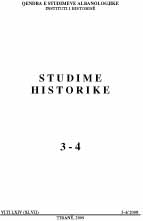Aspekte të veprimtarisë së Komunitetit Mysliman gjatë viteve të monarkisë në shtypin e kohës
Aspects of the activity of the Muslim Community during the monarchy period in the contemporary press
Author(s): Aida DukaSubject(s): History
Published by: Qendra e Studimeve Albanologjike
Keywords: activity of the Muslim Community ; monarchy period ; contemporary press; Albania; Albanian History;
Summary/Abstract: The historical developments through which our country has gone through have created a complex religious mosaic. However in this mosaic has been evident the sense a tolerance which has been obvious in the difficult moments our country has gone through in its history. The religion became an integral part of the national platform that aimed the preservation of the national existence and the declaration of the independence of the country. The religious tolerance was another element that became part of the difficult process of consolidation of the Albanian state. A balancing policy was pursued by the Congress of Lushnja that had in its High Council representatives from the four religious groups in country. The same policy was followed by Ahmet Zogu by appointing at the top of the communities reformatory elements and above all good patriots. The government through the laws of the state placed in lawful context aspects of the social life and family of its citizens. During the long trajectory of reformation it was not only the government and the intellectuals that were faced with the oldness but also the high clergy of religious communities with special emphasis of the Muslim one. Essential part of this movement was the Muslim community that gave an important help in the social emancipation of the country through the self-shaping. In the same manner this community had given a precious contribution for the National Movement and the achievement of the victory of the independence of the country where important figures such as Vehbi Dibra (Agolli), Hafiz Maliq, Haxhi Vildani had been distinguished. After the initiation of this process of inner reformation of the religious groups it was also initiated the work for the compilation of a law that would define the status of the religious communities in relation with the government. In effort to fulfil this aim it was approved the decree-law for the religious communities of 1923. These congresses opened the road for the inner reformation of the religious communities by defining the regulations and the statuaries. The most important decisions of the first Congress were: the clergy could by only Albanian, the preaching language to be used needed to be in Albanian, the reformation of the status of the Muslim woman by asking for the law that would have banned the use of the headscarf, an the training of the clergy for the translation of the holy writings in the Albania language. In the second congress were analysed administrative issues. The stand toward the civil code helped in the improvement of the image of the country in the international community. The real success of the third congress was the approval of the statue in which was defined the use of the Albanian language as the language of the prayers in all the hytbe.
Journal: Studime Historike
- Issue Year: 2008
- Issue No: 03-04
- Page Range: 113-132
- Page Count: 20
- Language: Albanian
- Content File-PDF

